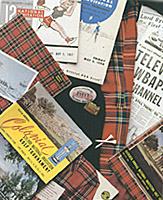1941 Craig Wood 284 (US Open)
1946 Ben Hogan 279
1947 Ben Hogan 279
1948 Clayton Heafner 272
1949 Flood, No tournament
Colonial’s successful 1941 U.S. Open was the impetus for creating its 50-year-old annual tournament, but no one planned to wait until 1946. Plans were underway in the summer of ’41 for an inaugural event the very next year. On August 19 the Fort Worth Star-Telegram reported on Colonial’s preliminary plans for a May 1942 tournament. Then the Japanese bombed Pearl Harbor and put that plan on the shelf.
But Colonial didn’t miss a beat after the conclusion of WW II. On May 29, 1945, just three weeks after V-E Day, the club announced formal plans for a 1946 golf tournament second to none. The world’s best golfers came to Fort Worth for Marvin Leonard’s showcase. The elite 29-man field featured 25 pros and four amateurs. Among the field were Toney Penna, Sam Snead, Lloyd Mangrum, Harold McSpaden, Jimmy Demaret, Vic Ghezzi, Lawson Little and Herman Keiser. They joined favorite sons Ben Hogan and Byron Nelson of Fort Worth.
Hogan captivated the city and the event by charging from three shots back on the last day for a thrilling one-stroke victory and a $3,000 first-place check. His incredible final-round 65 stood as the course record for 24 years.
With the first National Invitation Tournament a huge success, the event was off and running. Hogan won it the next year, too, battling Toney Penna down to the wire for a one-shot victory. This era was the heyday of Hogan’s emergence on Tour. In the 3 1/2 years between his discharge from the Army Air Corps (1945) and his infamous auto accident, Hogan won 37 tournaments. And after two more Colonial victories in the ’50s, local sports writers started calling the tournament the “Hogan Benefit.”
But Hogan probably would have also won the 1948 event for an NIT hat trick if not for the grueling match-play PGA Championship. That event immediately preceded Colonial’s 1948 affair, and did not end until Tuesday when Hogan won the finals after playing a total of 212 holes (nearly 12 rounds). He was exhausted, but only six back of Colonial’s leaders after two days. In Saturday’s third round, Hogan found the magic for another incredible 65, yet that was only good for second place. Big Clayton Heafner went on a four-day roll, blistering the course for a winning record of 272, eight-under-par.
Then came the cursed year of 1949. After winning two of the year’s first four events, Hogan and his wife, Valerie, headed home from the Phoenix Open (where he had finished second). It was the night of February 1, and they were east-bound on Highway 80 near Van Horn in far west Texas. A west-bound Greyhound bus attempted to pass a truck on a small bridge and met the Hogans head-on. Hogan’s last-second lunge in front of Valerie saved both of their lives, but he still suffered a fractured pelvis, broken collarbone, fractured and crushed left leg, and a fractured rib. His remarkable comeback from those life-threatening injuries would become one of the greatest stories in all of sports history.
1949 Flood at Colonial Three months later, on Monday, May 16, a five-inch deluge flooded the Trinity River and much of Fort Worth. A handful of people died and thousands were homeless. The National Invitation was two weeks away, and the golf course was 10-feet under water. Colonial officials, all their maintenance equipment washed away, vowed to clean up the course and stage the tournament on schedule. After four days, water service was restored to most of the city. The next Wednesday, May 25, more rain fell, with more flooding. It was just too much.
“We’re cancelling the tournament because the city has been struck by tragedy and we feel that this is no time to hold a golf tournament,” declared Marvin Leonard after meetings on Thursday. Club members were involved in volunteer relief efforts all over town, and the course would have to wait.
In hindsight it seems oddly fitting, though, that the tournament went unplayed. Without Ben Hogan, the 1949 NIT just couldn’t have been the same anyway. Was it fate? Or just a freak flood?
On December 10, 1949, a battling and courageous Hogan stepped onto the first tee at Colonial and played his first 18-hole round in 11 months. Things were looking up. 1950 would be a great year.






